特 别 关 注
高中各科资料汇总(11.16)
高中历史资料汇总(11.16)
高中化学120个关键知识点
高考作文视频讲解(1-10)
2020年高考优秀作文及评析11篇
历史干货丨 历史必修一至必修三复习资料
历史干货丨2021高考历史通史复习难点突破思维导图
历史干货丨高考必备知识——专题贯通与中外关联
历史干货丨一文搞懂美日俄的发展历程
干货丨高中政治易错点——经济篇!
干货 | 高考历史选择题易考易错知识点汇总,考试用的到!

易错点1 单个介词的误用
常见介词的基本用法
介词在英语中的使用很广泛,也是高考中的重点,正确使用介词是很重要的,下面归类讲述一些重点介词的用法:
一、表示时间的介词
1. in,on,at,over
(1)in表示在一段时间之内。通常时间较长,如世纪、朝代、时代、年、季节、月及一般(非特指)的早、中、晚等。如:
in the 1950s,in 1989,in summer,in January,in one’s thirties,in the morning等。
(2)on表示具体的某一天及其早、中、晚。如:
on May 1st,on Monday,on a cold night in January, on a fine morning等。
(3)at表示在一个时间点上。指某一时刻或较短暂的时间,也泛指圣诞节,复活节等。如:at 3:20,at this time of year,at Christmas,at night,at this moment等。
(4)over后面接一段时间,表示"超过……"或"在……期间"。
(5)在last,next,this,that,some,every等词之前通常不用介词。
2. in,after
(1)"in+一段时间"表示将来的一段时间之后。
(2)"after+一段时间"表示过去的一段时间之后。
(3)"after+具体时间"表示将来或过去的某一时刻之后。
3. from,since,for
(1)from后接具体时间,说明从什么时候开始,不说明某动作或情况持续多久。
(2)since后接具体过去时间,表示某动作或情况持续至说话时刻,通常与完成时连用。
(3)for后接一段时间,通常与完成时连用。
二、表示地点、方位的介词
1. at,in,on,to
(1)at表示在小地方或"在……附近;在……旁边"。
(2)in表示在大地方或"在……范围之内,在……方面"。
(3)on表示毗邻或接壤。
(4)to表示"在……范围外",不强调是否接壤。
2. above,over,on
(1)above意为"在……上方",只表示位置高于某物,但不强调是否垂直,与below相对。
(2)over意为"在……之上",表示垂直高于,与under相对。over强调与物体有一定的空间,不直接接触。
(3)on意为"在……之上",表示在某物体上面并与之接触。
易错点2 介词短语及语境混淆
常见介词短语:
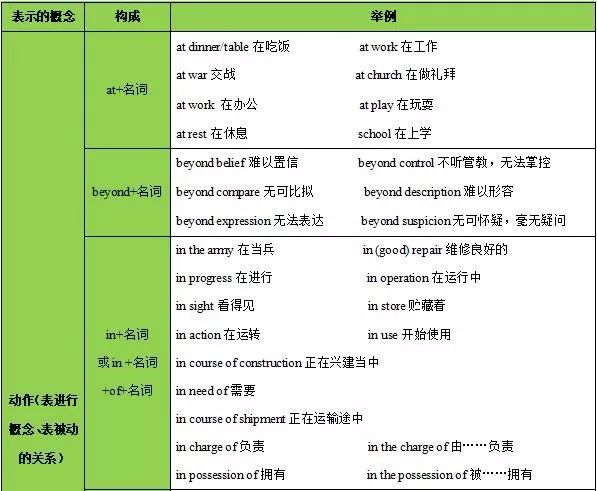
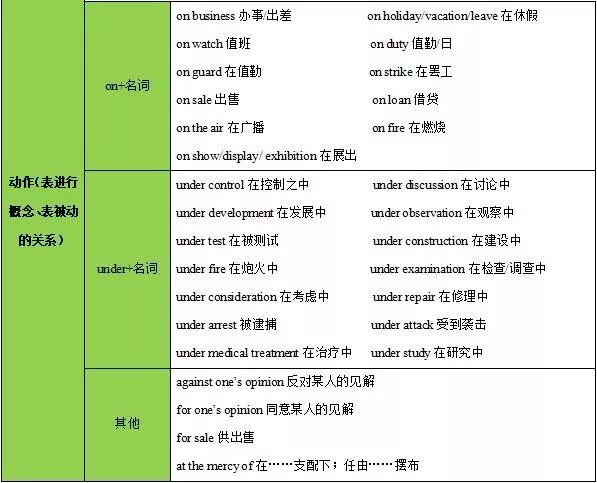
易错点3 介词搭配错误或缺失、多余
高考主要考查学生对固定短语的掌握程度、对短语意义的了解以及介词在固定搭配中的应用。常见的介词搭配有:
1. 名词词组:如solution/approach/way to……的方法;name of……的名字;entrance to/of……的入口等。
2. 动词词组:如remind sb. of sth.提醒某人某事;rob sb. of sth.抢劫某人的……;result from由……引起;call at访问(某地);lead to导致等。
3. 形容词词组:如be curious about对……好奇;be proud of因……而自豪;be popular with受到……的欢迎等。
4. 介词短语:如apart from除……之外;in addition to除……之外(还);because of因为;instead of代替;in fear of为……提心吊胆;for fear of以免;in case of防备,万一;thanks to由于;in the middle of在……中间according to根据;in front of在……前面;in return for作为对……的回报;in charge of负责;as a result of作为……的结果;in exchange for与……交换;on the contrary相反;in turn依次;in one’s opinion根据某人的看法;on time准时;out of reach够不着等。

易错点1 人称代词、物主代词和反身代词的误用
【特别提醒】
形容词性物主代词(my, your, his, her, its, our, their)只能在名词前作定语。如果名词前有形容词性物主代词,则不能再使用冠词(a, an, the)或指示代词(this, that, these, those)来修饰此名词。
名词性物主代词(mine, yours, his, hers, its, ours, theirs)相当于"形容词性物主代词+名词",在句中可作主语、宾语、表语,而不作定语。
在使用反身代词时,要注意其所在句子的主语。如果主语是I就用myself,是you就用yourself,he用himself,she用herself,it用itself,we用ourself,they用themselves。
1. 人称代词

2. 物主代词

【特别提醒】1. 英汉差异。英语中必须有形容词性物主代词,而汉语中往往省略不翻译。
Jack took off his coat and went go bed.(his不能省略)
2."of+名词性物主代词"用作定语。
Some friends of mine will attend my birthday party.
That car of hers is a1ways breaking down.
3."形容词性物主代词+own+名词"表示强调,在own前还可加very表示进一步的强调。
It’s nice if a man can have his own car.
I want to have my very own car.
4."a(an,some,any) +名词+ of one’s own"表示"某人自己的……"的意思。名词前可以用this, that, these, four, those, several, another, no等修饰,但不能用定冠词the。
5. 含有反身代词的习惯用语:
by oneslf( =alone) 独自地,亲自to oneself 暗自
for oneself 为自己of oneself 自动地,自发地
be oneself 玩得愉快dress oneself in 穿着……
help oneslf to 随便吃……,自行取用come to oneself 苏醒
make oneself at home 不要客气devote oneself to 专心于;献身于……
find oneself in/at发觉自己来到……teach oneself 自学
dress oneself 自己穿衣lose oneself 迷路
易错点2 不定代词的误用
不定代词有all, both, every, each, either, neither, more, little, few, much, many, another, other, some, any , one, no 以及some, something, anything, everything, somebody, someone, anybody, anyone, nothing, nobody, no one, none, everybody, everyone等。
(一)不定代词的基本用法:

(二)复合不定代词的用法

【特别注意】
all,both,everyone,everybody,everything以及"every+名词"都表示全部肯定。
none,no one,nobody,nothing,neither,not any 以及"no+名词"均表示全部否定;但当not 与表示全部肯定的不定代词连用时,不管not的位置在其前还是其后,都表示部分否定。
☛None of them smoke. (全部否定)
他们都不吸烟。
☛Such a person can’t be found everywhere.(部分否定)
这种人并非随处可见。
(三)指示代词
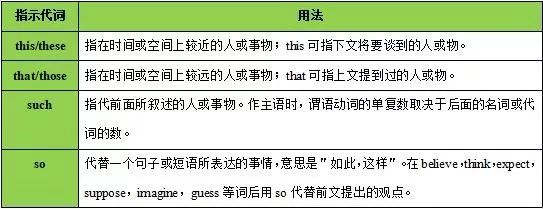
几组相似的不定代词:
1. all, both, either, neither, each和none
(1)both(两者都),either(两者中的任何一个),neither(两者都不)。以上这些词使用范围为两者。
☛John and Mary have both won the prizes. 约翰和玛丽都得了奖。
☛The research group produced two reports based on the survey, but neither contained any useful suggestions. 这个调查组在调查的基础上提供了两份报告,但是没有一份包含有用的建议。
☛I’ve lived in New York and Chicago,but don’t like either of them very much. 我曾经在纽约和芝加哥居住过,但是这两个城市我都不是很喜欢。
(2)both与复数名词连用,either与单数名词连用。
☛There are flowers on both sides of the street. 街道两旁都有花。
☛There are flowers on either side of the street. 街道的每一边都有花。
(3)all(所有的,全部的人或物),any(任何一个),none(都不)。以上词使用范围为三者或三者以上。
☛All the students in my class like our teachers. 我们班的所有学生都喜欢我们的老师。
☛Although Rosemary had suffered from a serious illness for years,she lost none of her enthusiasm for life. 虽然罗斯玛丽患上这种严重的疾病多年,但是她一点儿也没有失去对生活的热情。
(4)each可指两者,也可指两者以上。
☛They each have a car. 他们都有车。
2. no,none,nobody和nothing
(1)no不能单独使用,相当于not a或not any,作定语修饰可数名词或不可数名词。
☛He has no worry about safety. 他一点也不为安全担心。
(2)none既可以指人,也可以指物,侧重指三者或三者以上的人或物,可与介词of连用,用于回答how many/much引出的疑问句。
☛—How many people are there in the room? 房间里有多少人?
—None. 没有人。
(3)nobody指人,用于回答who引导的疑问句;nothing指物,用于回答what引出的疑问句。
☛The meeting will be held in September, but nobody knows the date for sure. 这次会议将在9月举行,但没人知道确切的日期。
☛—What are you doing? 你正在做什么?
—Nothing.没干什么。
易错点3 指示代词的误用
指示代词是用来指代或标记人或事物的代词,有this,that,these,those。this,that是单数,these,those是复数。指示代词可以在句中作主语、宾语、表语和定语等。
几组常见的指示代词的辨析:
1. it,one,ones,that,those
(1)it特指上文所提到的同一事物,它所代替的名词常由the,this,that等修饰。
(2)one泛指上文提到的同类事物中的一个,不特指,相当于"a/an+单数名词";the one特指前面的可数名词单数,有时可以用that来代替(尤其是后面有后置定语时);
(3)ones泛指上文提到的同类事物的复数名词;the ones特指上文提到的复数名词,有时可以用those代替,尤其在有后置定语的情况下。
(4)that特指前面出现的单数名词或不可数名词,相当于"the+可数名词单数/不可数名词";that 的复数形式为those,替代可数名词复数,既可指人也可指物。
☛Yesterday I lost my pen and I couldn’t find it. So I had to buy one.(it指代my pen;one替代a pen) 昨天我丢了钢笔而且没找到。所以我不得不再买一支。
☛The books on the desk are better than those/the ones under the desk.(those/the ones替代the books) 桌子上的书要比桌子下面的好。
☛Few pleasure can equal that of a cool drink on a hot day. 没有什么能比得上在炎热的天气里喝上一杯冷饮那样快乐。(that替代pleasure)
【特别注意】
that既可替代可数名词单数,也可替代不可数名词,常有后置定语,一般不指人,复数形式为those;one只能替代可数名词单数,复数形式为ones。当可数名词前有形容词修饰时,只能用one,不用that。当of短语做可数名词单数的后置定语时,用that,不用one。
2. another,other,the other和others
(1)another既可以单独使用,也可以用于单数名词前,泛指三者或三者以上中的"另外一个人或物"。还可以用于"another+数词+复数名词"中,表示"再,又"。
☛Recycling is one way to protect the environment; reusing is another. 循环利用是保护环境的一种方式,重新利用是另一种方式。
☛You have to wait for another three weeks. 你还得等待三周。
(2)other 可用作形容词,意思为"别的,其他的",泛指"其他的(人或物)"。
☛You can ask other people to help you. 你可以让其他人帮你。
(3)the other指两个人或物中的一个,不能用another,此时other为代词。
☛The old man has two sons.One is a teacher; the other is a doctor. 这位老人有两个儿子。一个是老师,另一个是医生。
(4)the other 后可接可数名词单数,也可接可数名词复数,不接不可数名词。此时other为形容词。
☛On the other side of the street, there is a tall tree. 在街道的另一边,有一棵高大的树。
☛He is taller than the other students in his class. 他比班里其他学生都高。
(5)others 是other的复数形式,泛指"另外几个;其他的"。others不能作定语,表示复数意义,相当于"other+复数名词";the others相当于"the other+复数名词",指剩下的全部。
☛In some countries,people eat with chopsticks,while in others,knives and forks. 在一些国家里,人们用筷子吃饭,而在另一些国家里,,人们用刀子和叉子。
☛Two students in our class failed,but all the others passed the exam. 班里两个学生没及格,但其他学生全部通过了考试。
易错点4 代词it的误用
it的用法考点透析:
(一)it作为代词,与one,that的辨析
1. it
特指,代替单数可数名词,一般代替一个具体的事物,不带修饰成分。
(1)用作人称代词,代替前文提到的事物。
☛—What’s this?这是什么?
—It’s a pen. 钢笔。
(2)代替指示代词this,that。
(3)表示时间、天气、距离、季节、明暗等。
☛—How far is it to New York? 纽约有多远?
—It’s 400 kilometers. 400公里。
2. one
(1)泛指,代替前面出现过的名词单数,避免重复(用ones代替前面出现过的复数名词)。可用this/that/each/which及形容词修饰,也可与冠词连用,或带后置定语。
☛He has no child, and he wants to adopt one. 他没有孩子,想认养一个。
(2)作不定代词时,可以泛指人,意为"一个人,一种人"。
☛One should do one’s duty. 人人应该尽责。
比较:
☛There was a piano in the shop, so I decided to buy it at once.
店里有一架钢琴,我决定立刻买下来。(it 特指上文出现的piano, 与piano是同一事物)
☛I wanted to buy a house and I’d like one with a garden.
我想买个带花园的房子。(one=a house)
☛There are many good flats for you to choose.Would you like to buy one?
有许多好的公寓让你选择,你要买一套吗?(one=a flat, one 指many good flats中的一个)
3. that
代替单数可数名词或代替不可数名词,只可带后置定语。只能代替物,不能代替人。those可指人,也可指物;在比较状语从句中,特指前面提到的同一类东西。
☛The population of Shanghai is larger than that of Beijing. 上海的人口多于北京。
(二)it作形式主语时的常见句型:
1. It is (high) time (that) 主语+should do/did sth.
☛It is (high) time that this problem was solved. 是时候解决这个问题了。
2. It is...since...
☛It is two years since he came to work in this city. 自从他来到这个城市工作已经两年了。
3. It be...before...
☛It will be three years before we can meet again. 我们要三年才能相见。
4. It is/was+adj.+for/of sb.to do sth.
☛It was difficult for her to move so heavy a box. 叫他搬这么重的箱子有点难。
5. It is/was+adj.+that...
☛It was clear that he was lying to us. 很明显他在对我们说谎。
6. It is+ved+that...
☛It is reported that our team has won the gold medal. 据报道我们队获得了金牌。
7. It seems/appears/happens that...
☛It seemed that he had known the truth. 看来他已经知道了真相。
8. It matters/doesn’t matter that...
☛It matters a lot whether he will agree to our plan. 他是否同意我们的计划关系重大。
9. It is no use/no good/no harm doing sth.
☛It’s no good arguing with him. 与他争吵没好处。
(三)it作形式宾语的常用句型(S代替主语,V代替谓语动词)
1. S+V+it+adj./n.+to do sth.
☛We consider it a great honor to be able to host the 2020 Olympic Games. 我们认为能举办2020奥运会是极大的荣幸。
2. S+V+it+adj./n.+doing sth.
☛They find it no use searching the empty house. 他们发觉搜寻这座空房子没用。
☛Do you consider it any good trying again? 你认为再试一次没有任何好处?
3. 主语+谓语+it+that/when...
☛I don’t like it when you shout at me. 我不喜欢你对我大喊大叫。
4. 强调句:It is/was+被强调成分+who/that...
如:可对下列句子中四处画线部分进行强调。
☛We saw Tom in_the_park yesterday. 我们昨天在公园看见汤姆。
→It was we who/that saw Tom in the park yesterday.
(强调主语,为人,可用who或that) 是我们昨天在公园看见汤姆的。
→It was Tom who/that we saw in the park yesterday. (强调宾语) 昨天我们在公园看见的是汤姆。
→It was in_the_park that we saw Tom yesterday. (强调地点状语) 我们昨天是在公园看见汤姆的。
→It was yesterday that we saw Tom in the park. (强调时间状语) 我们是昨天在公园看见汤姆的。
【温馨提示】
1. It is...that … 不能用来强调谓语动词,强调动词要用"do+动词原形"。
☛Do come early tomorrow. 明天一定要早点来。
☛The little boy did work out the problem. 小男孩的确做出了那个题目。
2. 强调时间、地点、某个事物时都要用that,而不能用when,where,which。

常考介词辨析
介词是英语中最活跃的词类之一,使用频率相当高,其用法跟冠词一样复杂。介词按其词义可分为下列几种:
1. 表示方向、地点。如:about,across,after,among,around,behind,below,beside,beyond,down,from,into,off,over,throughout,towards,up,within,without 等。
2. 表示时间。如:about,after,around,as,at,before,behind,between,by,during,for,from,in,into,of,on,over,past,since,through,till(until),to,towards,within 等。
3. 表示除去。如:besides,but,except 等。
4. 表示比较。如:as,like,above,over 等。
5. 表示赞同、反对。如:for,against 等。
6. 表示原因、目的。如:for,with,from 等。
7. 表示结果。如:to,with,without 等。
8. 表示手段、方式。如:by,in,with 等。
9. 表示所属。如:of,with 等。
10. 表示条件。如:on,without,considering 等。
11. 表示让步。如:despite,in spite of等。
12. 表示关于。如:about,concerning,regarding,with regard to,as for,as to 等。
13. 表示对于。如:to,for,over,at,with 等。
14. 表示根据。如:on,according to 等。
但根据近年来高考命题的情况来看,考生需要掌握以下内容:
1. 表示相同或相似概念的介词(短语)的区别



2. 常见同一形容词与不同介词搭配时意义上的差别
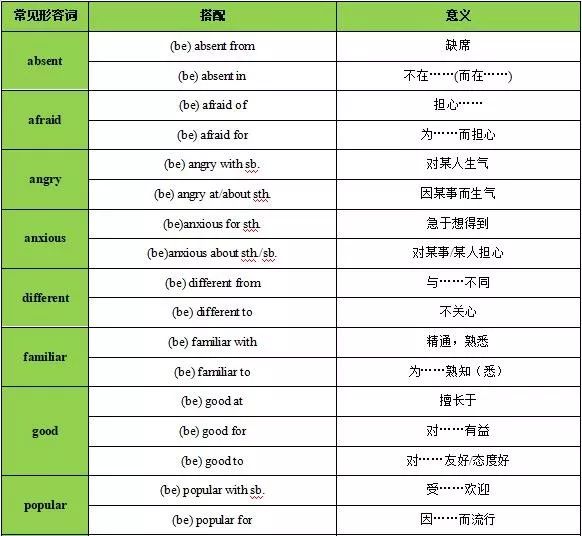
3. 容易混淆的含有介词固定搭配的词组


几组易混不定代词的用法区别:
1. some和any
二者都可用作名词(作主语或宾语),也可用作形容词(作定语)来修饰可数名词或不可数名词。
(1)some一般用于肯定句中。当some用于单数可数名词前时,表示"某一(个)",与数字连用则有"大概,大约"的意思;用于疑问句时,表示说话人希望得到肯定的回答,或表示请求、建议。
☛I’ve read the story in some book. (某一本)
☛Some girl. is waiting for you at the school gate.(某个)
☛The country has exported some two million bikes this year. ( 大约 )
☛May I have some water? (表示请求)
☛Would you like some apples? (邀请)
(2)any多用于疑问句,否定句和条件句中。在肯定句中,any表示"任何的",修饰单数可数名词。也可用作状语,表示程度。
2. much和many
(1)both两者都,all三者或三者以上,全体;在句中可作主语、宾语、定语和同位语。
(2)all指人,作主语时,谓语动词用复数;指物,表示"所有,一切",作主语时,谓语动词用单数,也可用来作定语,修饰不可数名词。
☛All but one are present.(作主语,指人,谓语动词用复数)
☛All is over with him.(作主语,指物,谓语动词用单数)
☛I have forgotten all about it(作宾语)
☛All hope has gone.(修饰不可数名词)
☛They all agree to stay here.(作同位语)
3. much和many
两个词都有"许多"的意思,much表示或修饰不可数名词,many表示或修饰可数名词。在口语中,much或many多用于疑问句或否定句,在肯定句中常用a lot of,lots of,plenty of,a large quantity of,quantities of代替。much还可以用a great deal of代替,many可以用a (1arge) number of代替。
(1)much可用作副词,作状语,表程度。be not much意为"不怎么样",much还可与too连用构成"too much+不可数名词"短语,意为"太多的……","much too+形容词或副词",意为"太……,非常……",是副词词组,修饰形容词、副词,但不修饰动词。
☛The city is much larger than that one.
☛I’ve visited the country and it is not much.
☛There is too much noise in the classroom.
☛I’m much too busy to see visitors.
(2)many a + 可数名词单数,表示"许多"。在名词前如果有冠词或指示代词等词时,要用many of或much of结构。
☛Many a student has gone to the cinema.
☛Many of the/my books are English.
4. each和every
(1)each强调个体,在句子中充当定语、主语、宾语和同位语,指两者或两者以上的人或事物中的每一个。
☛Each room can seat at least fifty people.
☛Each of the students will get a new book.
☛Each student will get a new book
☛The students each will get a new book.
☛There are trees and flowers on each side of the street. (街道只有两边,不能用every)
(2)every强调整体,在句中只能作定语,指三者或三者以上的人或事物中的每一个。还可以构成"every+数词+复数名词","every + few + 复数名词""every + other + 单数名词""every +序数词 +单数名词"表示"每隔……"。
☛Every one has strong and weak points.
☛Every student has told a story.
☛every three weeks 每隔三个星期,每隔两个星期
☛every other week = every second week 每隔一星期
☛every few weeks(不能说evesy a few weeks) 每隔几个星期
4. either 和neither
either指"两个人或物中的任何一个",表示肯定意义;neither指"两个人或物一个也不",表示否定意义。这两个词作主语时,谓语动词要用单数。
①either可放在否定句的句尾,表示"也"。
☛I don’t know either. 我也不知道。
②either可用作连词,"或者,要么"的意思,一般与。or连用,构成"either... or"短语,意为"不是……而是……","或者……或者……"。当这一短语连接两个名词或代词作主语时,谓语动词在人称和数上要同最近的主语保持一致。
☛Either he or I am to blame.
☛Is either he or you going to the cinema?
☛Are either you or he going to the cinema?
③either修饰名词时,前面不用物主代词,指示代词或定冠词,可以说"either pen",但不能说"the either pen或either my pen"。
④either用作代词时,可以单独使用,也可和of连用,of后接复数名词,名词前要用一个物主代词,指示代词或定冠词。
☛He doesn’t like either of the two places.
⑤当either of作主语时,动词一般用单数形式,但在否定句和疑问句中,动词也常用复数,特别在口语中。
☛Either of them is good enough.
☛I don’t think either of them are at home.
6. no和 none
(1)no表示"不""无",只能作定语,修饰不可数名词或可数名词单复数,相当于not any或not a。
☛There is no water in the bottle.
(2)none表示"没有人,任何人也不",用作名词,相当于no one或not any,常同of连用,构成"None of..."结构,none作可数名词用时,指三者或三者以上。作主语时谓语动词用单数或复数均可,none作不可数名词时,谓语动词用单数。none在句中作主语或宾语,不作定语,不与名词连用。
☛None of the books are (is) interesting.
【特别注意】
1. "none but+复数名词"作主语时,谓语动词要用复数。
☛None but wolves walk like that.除非狼才会那么走。
2. none和noone的区别:
none回答以howmany/much引出的特殊疑问句或"any of + 限定词 + 名词"或表一定范围的一般疑问句,no one回答以who引出的特殊疑问句及含有anybody或无限定范围的一般问句,简言之,none表示数量,no one表示没有人。
☛— How many students are there in the classroom now?
—None.
☛—How any of you ever been to the Great Wall?
—None.
☛—Who can answer the question?
—No one.
7. other,another, others,any other和the other
(1)other表示泛指,意为"另外的,其他的",常与复数名词或不可数名词连用。如果其前有the,this,some,any,each,every,no以及形容词性物主代词时,其后就可接单数名词。
☛I have no other place to go.
(2)another常用于指三者或三者以上中的"另外一个",泛指单数。可以单独使用,也可以接名词。如果其后接复数名词,则表示"又,再,还"。
☛This cap is too small for me. Show me another (one).
☛We need another three assistants in our company.
(3)others是other的复数形式,表示泛指,意为"别的人或物",但不指全部。特指时在其前加定冠词;前面可加任何限定词以及数量词。
☛He has more concern for others than for himself.
(4)any other表示一个之外的其他任何一个,而不是两个之中的另一个。
☛China is larger than any other country in Asia.
(5)the other表示两者中的另外一个。可以单独使用,也可接单数名词。
☛No agreement was reached in the discussion as neither side would give away to the other.
【巧学妙记】
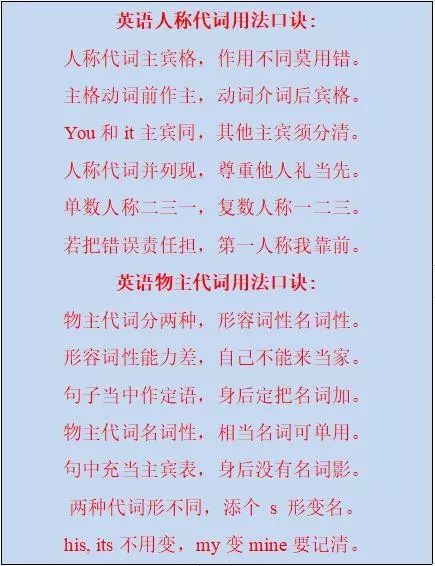

往期精彩
高中各科资料汇总(11.16)
高中历史资料汇总(11.16)
高中化学120个关键知识点
高考英语听力十大场景必备词汇,记住了你也能拿高分!
干货 | 高中英语要考的所有定语从句考点都在这里了!
书面表达 | 近十年高考英语100个好句,英语作文快速提分就靠它了!
历史干货丨高考历史材料题30个高频考点的答题术语
语文学习方法的精髓!
诗歌鉴赏(手法)思维导图,高中生必备!
整理 | 高中生物必修1-必修3必背知识点,看这个就够了!
近十年高考100个英语作文金句沉淀(上)
近十年高考100个英语作文金句沉淀(下)
高考英语大纲规定的24个语法梳理(一)
高考英语大纲规定的24个语法梳理(二)
高考英语大纲规定的24个语法梳理(三)
高考英语大纲规定的24个语法梳理(四)
高考英语大纲规定的24个语法梳理(五)
























 被折叠的 条评论
为什么被折叠?
被折叠的 条评论
为什么被折叠?








